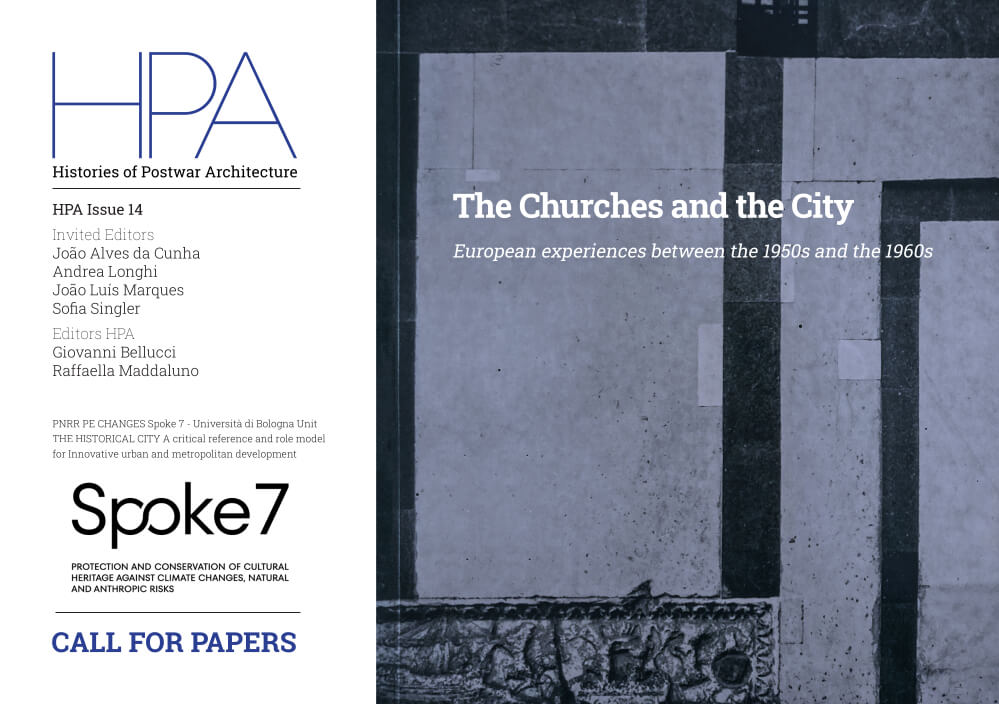The Churches and the City: European experiences between the 1950s and the 1960s - Call for Papers - HPA 14/2023

The Cardinals Josef Frings (1887-1978) in Cologne, Manuel Gonçalves Cerejeira (1888-1977) in Lisbon and Giacomo Lercaro (1891-1976) in Bologna between the 1950s and 1960s are at the apex of a geographical triangle with dense relations that have not yet been exhaustively explored. Committed to the liturgical movement and the conciliar debate, Frings, Gonçalves Cerejeira and Lercaro – in a lively framework of episcopal initiative at the European level – promoted a cultural revolution in little more than ten years that would have important consequences not only from an architectural and artistic point of view in the Catholic sphere, but also in other Christian denominations.
In this sense, no less significant are the experiences in Austria, France, Spain and Northern Europe where architects are involved by patrons – more or less pastorally up-to-date – in the construction of new religious centres. The construction – or more limitedly, the debate on these new ecclesiastical buildings alone – contributes to weaving a dense web of relationships that constitute an extremely significant chapter in the history of architecture and town planning in the second half of the 20th century. The relations established between the ecclesiastical hierarchies, politicians, intellectual scholars of religious and social sciences, architects and artists lead to the construction of thousands of new churches throughout Europe in a short time, even before the post-conciliar revolution. These were immediately understood by all the institutional stakeholders and communities involved not only as indistinct pieces of the complex mosaic of the neighbourhood, but as identity points of the new settlement realities, architectural, social and cultural nerve centres for the residents. The ecclesiastical system, in the same years, is reorganised not only in the expansion areas, but also in the more stratified neighbourhoods: the restoration of churches damaged during the war, the debate on the issue of ‘historic centres’, the demographic and social transformations of the historic city districts change the function and significance of the religious presence, prompting delicate operations of reconstruction, abandonment, transformation or replacement of pre-existing complexes.
The call wants to shed new light on these stories, leaving total freedom on topics, sources and research themes. From the contribution made by journals close to the liturgical movement in each country («Chiesa e quartiere» in Italy, «Das Munster» in Germany, «Ara» in Spain, «Kunst und Kirche» and «Christliche Kunstblatter» in Austria, «L’Art d’Eglise» in Belgium, «Construire l’Eglise» and «Chemin Neuf» in France etc.) and journals of urban studies and planning, to the work of study centres and agencies specialising in the pastoral infrastructure of cities, to the work of local designers often neglected by critics (among them Giorgio Trebbi in Italy, Miguel Fisac Serna in Spain, Osmo Sipari in Finland and many others) or of well-known international architects including Rudolf Schwarz, Alvar Aalto or Le Corbusier. Equally significant are the exhibitions on the new churches organised in Cologne in 1959 and in Bologna in 1955 and 1960 and what came out of them, the Biennal of Sacred Art in Salzburg, the SIAC (International Society of Artists of the Christian Faith) congress in Copenhagen in the summer of 1965 and then in Bologna in 1967 as well as many other events in those years that contributed to a tangible confrontation between the parties and testified to the value of the events. The contribution and the action promoted by other bishops, perhaps even less investigated, such as Cardinals Jozef-Ernest Van Roey (1874-1961) in Belgium and Gregorio Modrego (1890-1972) bishop of Barcelona from 1943 to 1967 who, like the aforementioned were at the centre of the cultural ferment of their dioceses, further implement the list of protagonists and possible geographies under study.
Papers should be submitted in English using
https://hpa.unibo.it/user/register
The guidelines for paper submission are available at
https://hpa.unibo.it/about/submissions#authorGuidelines
Please, fill in the author’s profile with all the informations required as:
- Applicant’s name
- Professional affiliation
- Title of paper
- Abstract
- 5 keywords
- A brief CV (max 2,000 characters)
Please submit the proposal in the form of MS Word (length between 20,000 and 80,000 characters). The submitted paper must be anonymous. Please delete from the text and file’s properties all informations about name, administrator etc. Papers should clearly define the argument in relation to the available literature and indicate the sources which the paper is based on. All papers received will go through a process of double-blind peer review before publication.
HPA also looks for contributions for the review section:
https://hpa.unibo.it/about#sectionPolicy
To addressed questions to the editors:
redazione.hpa@unibo.it
The call is linked to the International Conference “THE CHURCHES AND THE CITY. European experiences between the 1950s and the 1960s”
https://events.unibo.it/churchandcity
A selection of papers accepted for the Conference will be published in HPA
Authors may also submit full papers directly to HPA by 31 December 2023
Acceptance of full papers implies the possibility of participating in the conference as an invited speaker
Publication is expected to be in June 2024




